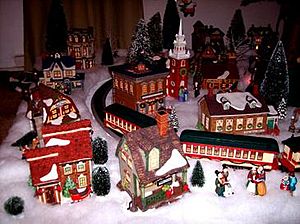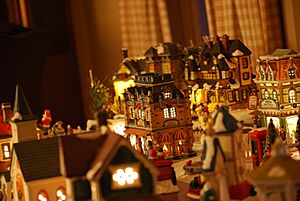Christmas village facts for kids
A Christmas village is a fun, miniature display of buildings and scenes. People often set them up during the Christmas season. These tiny villages are sometimes called a putz. The idea for them comes from old Christmas traditions of the Moravian church, which is a type of Protestant church.
In the early to mid-1900s, many cardboard Christmas villages were made. They became very popular in the United States. Later in the century, villages made from porcelain or ceramic became popular too.
Contents
The Story of Christmas Villages
How They Started
The tradition of building decorative Christmas villages began a long time ago. It started in the late 1700s with the Moravian church. This church had early settlements in places like Salem, North Carolina and Bethlehem, Pennsylvania.
These early displays were called "putz." The word "putz" comes from a German word meaning "to decorate." A putz was often a detailed landscape with animals. It might show the stable where Jesus was born, or even scenes from Noah's Ark.
Over time, these putz displays grew much larger. They could include working flour mills, jumping dogs, and even electric trains. Some were so big they filled an entire room! Families would have "putz parties" and even compete to see who had the best display.
Made for Everyone
After World War II, companies in Japan started making many cardboard or paper houses. They also made churches and other buildings for Christmas villages. These small buildings usually had holes in the back or bottom. People would put Christmas lights inside to make them glow.
The buildings often had tiny colored windows that looked like stained glass. Their roofs were covered with a sparkly powder to look like snow. These buildings were cheap and easy to find. This made them a very popular Christmas decoration across the United States.
Modern Villages Today
In the 1970s, new Christmas villages appeared. These were made from ceramic or porcelain and quickly became popular. Department 56 was one of the first companies to make these detailed buildings. They are still one of the most famous brands today.
Other companies, like Lemax, also make similar villages. In Europe, brands like Luville and Dickensville are well-known.
You might notice that buildings in Christmas villages are not always the same size as they would be in real life. For example, a church might be much taller than a house in reality. But in a village display, the church just needs to be noticeably taller. This makes it look important without being too big for the display.
The idea of creating miniature villages for holidays has spread. Now, some companies even make villages for Halloween and Easter!
See also
 In Spanish: Pueblo navideño para niños
In Spanish: Pueblo navideño para niños




